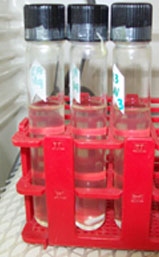
|
|





When grown in sealed tubes with slow stirring, tubercle bacilli cease replicating when oxygen concentrations decrease to the microaerobic level (1% oxygen saturation) and they enter a nonreplicating persistence state (NRP-1). With continued incubation the oxygen levels decrease to anaerobic levels (0.06% oxygen saturation) and the second state, NRP-2 follows. This model has been used extensively as a simple model of dormancy for M. tuberculosis. This model was developed by Lawrence Wayne here at the VA in Long Beach and is therefore often called The Wayne Model. |
The Wayne Model utilizes tightly sealed slowly stirred tubes. The stirring is accomplished with the use of a "mag flea". This is a very small Teflon-coated magnetic 8 mm stirring bars. |
The stirring is performed by a slow speed stirrer. Many stir plates designed for mixing rotate too quickly to be used. The stirring should be just fast enough to keep the cells from settling without disturbing the surface of the medium. We use stir plates made for cell culture (not mixing) set at 120 rpm. |
References for the Wayne Model Wayne, L.G. and Hayes L.G. 1996. An in vitro model for sequential study of shiftdown of Mycobacterium tuberculosis through two stages of nonreplicating persistence. Infect Immun 64:2062-2069 Wayne, L.G. and Sohaskey, C.D. 2001. Nonreplicating persistence of Mycobacterium tuberculosis. Annu Rev Microbiol 55:139-163. Wayne, L.G. In Vitro model of hypoxically induced nonreplicating persistence of Mycobacterium tuberculosis. In T. Parish and N.G. Stoker (ed.), Methods in Molecular Medicine. 54:247-269. |